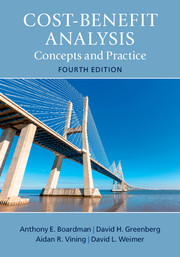Chapter 5 - Valuing Benefits and Costs in Secondary Markets
from PART II - FUNDAMENTALS OF CBA
Summary
In conducting CBAs of government policies, there is a natural tendency to list as many effects of the policies as one's imagination permits. For example, an improvement in public transportation in a particular city may increase bus usage and reduce car usage. It may also reduce downtown pollution and congestion. In addition, it may reduce the demand for automobile repairs, parking places, and gasoline.
To assess these effects, one must first determine which occur in primary markets and which occur in secondary markets. Primary markets refer to markets that are directly affected by a policy, while secondary markets are markets that are indirectly affected. The changes in bus usage previously mentioned clearly occur in the primary market for public transportation. The reductions in pollution and congestion also can be thought of as occurring in the primary market for public transportation, though these particular impacts are in the external, or missing, part of that market. Any effect that occurs in a primary market should be accounted for in a CBA. On the other hand, effects on the demand for auto repairs, parking places, and gasoline occur in secondary markets and, as will be seen, often can (and indeed should) be ignored in conducting CBA. This last group of effects is often referred to as secondary, second-round, spillover, side, pecuniary, or indirect effects.
While Chapter 4 examined the benefits and costs of government policies that occur in primary markets, this chapter focuses on policy impacts in secondary markets. As in Chapter 4, we distinguish between efficient and distorted markets. In addition, the chapter takes a brief look at the special implications of secondary market effects for local communities, as the benefits of such effects are often touted by advocates of local infrastructure projects such as sports stadiums and convention centers.
VALUING BENEFITS AND COSTS IN EFFICIENT SECONDARY MARKETS
Complements and Substitutes
Secondary market effects result because government policies affect the prices of goods in primary markets, and this, in turn, noticeably affects the demand for other goods. These latter goods are referred to as complements and substitutes.
- Type
- Chapter
- Information
- Cost-Benefit Analysis , pp. 115 - 132Publisher: Cambridge University PressPrint publication year: 2017



